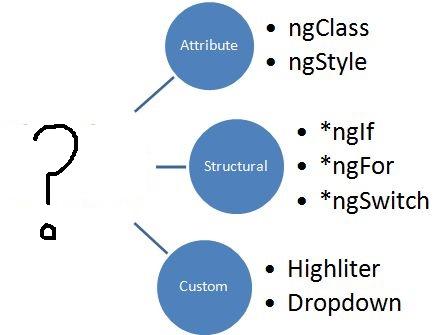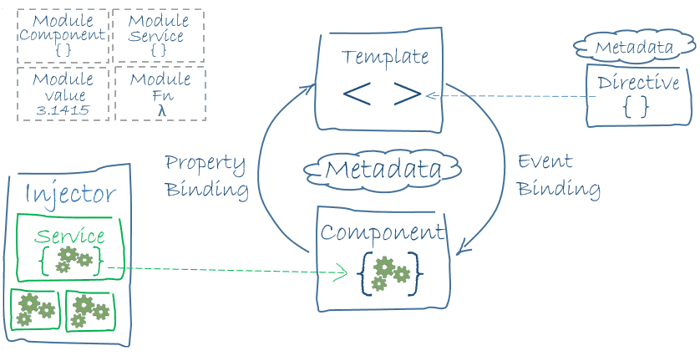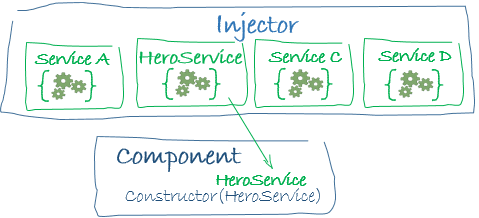Angular Interview Questions
1) What is Angular?
Angular is a TypeScript-based open-source web application framework, developed and maintained by Google. It offers an easy and powerful way of building front end web-based applications.
2) Define the ng-content Directive?
Conventional HTML elements have some content between the tags. For instance:
3) Please explain the various features of Angular.
There are several features of Angular that makes it an ideal front end JavaScript framework. Most important of them are described as follows:
4) Demonstrate navigating between different routes in an Angular application.
Following code demonstrates how to navigate between different routes in an Angular app dubbed “Some Search App”:
.
.
.
@Component({
selector: 'app-header',
template: `
<nav class="navbar navbar-light bg-faded">
<a class="navbar-brand" (click)="goHome()">Some Search App</a>
<ul class="nav navbar-nav">
<li class="nav-item">
<a class="nav-link" (click)="goHome()">Home</a>
</li>
<li class="nav-item">
<a class="nav-link" (click)="goSearch()">Search</a>
</li>
</ul>
</nav>
`
})
class HeaderComponent {
constructor(private router: Router) {}
goHome() {
this.router.navigate(['']);
}
goSearch() {
this.router.navigate(['search']);
}
}
5) Could you explain services in Angular?
Singleton objects in Angular that get instantiated only once during the lifetime of an application are called services. An Angular service contains methods that maintain the data throughout the life of an application.
6) Discuss the advantages and disadvantages of using Angular?
Following are the various advantages of using Angular:
7) Enumerate some salient features of Angular 7.
Unlike the previous versions of Angular, the 7th major release comes with splitting in @angular/core. This is done in order to reduce the size of the same. Typically, not each and every module is required by an Angular developer. Therefore, in Angular 7 each split of the @angular/core will have no more than 418 modules.
8) What is string interpolation in Angular?
Also referred to as moustache syntax, string interpolation in Angular refers to a special type of syntax that makes use of template expressions in order to display the component data. These template expressions are enclosed within double curly braces i.e. {{ }}.
9) Explain Angular Authentication and Authorization.
The user login credentials are passed to an authenticate API, which is present on the server. Post server-side validation of the credentials, a JWT (JSON Web Token) is returned. The JWT has information or attributes regarding the current user. The user is then identified with the given JWT. This is called authentication.
10) Can you explain the concept of scope hierarchy in Angular?
Angular organizes the $scope objects into a hierarchy that is typically used by views. This is known as the scope hierarchy in Angular. It has a root scope that can further contain one or several scopes called child scopes.
11) How to generate a class in Angular 7 using CLI?
12) Explain what is the difference between Angular and backbone.js?
Following are the various notable differences between Angular and Backbone.js
13) How do Observables differ from Promises?
As soon as a promise is made, the execution takes place. However, this is not the case with observables because they are lazy. This means that nothing happens until a subscription is made. While promises handle a single event, observable is a stream that allows passing of more than one event. A callback is made for each event in an observable.
14) Please explain the difference between Angular and AngularJS?
Various differences between Angular and AngularJS are stated as follows: What should replace the “?”?
What should replace the “?”?
Directives. The image represents the types of directives in Angular; Attribute, structural, and custom.
16) Could you explain the concept of templates in Angular?
Written with HTML, templates in Angular contains Angular-specific attributes and elements. Combined with information coming from the controller and model, templates are then further rendered to cater the user with the dynamic view.
17) What should replace the “?”?
Directives. The image represents the types of directives in Angular; Attribute, structural, and custom.
18) Explain the difference between an Annotation and a Decorator in Angular?
In Angular, annotations are used for creating an annotation array. They are only metadata set of the class using the Reflect Metadata library.
19) What are directives in Angular?
Directives are one of the core features of Angular. They allow an Angular developer to write new, application-specific HTML syntax. In actual, directives are functions that are executed by the Angular compiler when the same finds them in the DOM. Directives are of three types:
20) What are the building blocks of Angular?
There are essentially 9 building blocks of an Angular application. These are:
21) Please explain the differences between Angular and jQuery?
The single biggest difference between Angular and jQuery is that while the former is a JS frontend framework, the latter is a JS library. Despite this, there are some similarities between the two, such as both features DOM manipulation and provides support for animation.
Although both Angular expressions and JavaScript expressions can contain literals, operators, and variables, there are some notable dissimilarities between the two. Important differences between Angular expressions and JavaScript expressions are enlisted below:
You can draw some like this: Here is Angular Architecture in detail: https://angular.io/guide/architecture
Here is Angular Architecture in detail: https://angular.io/guide/architecture
24) What is Angular Material?
It is a UI component library. Angular Material helps in creating attractive, consistent, and fully functional web pages as well as web applications. It does so while following modern web design principles, including browser portability and graceful degradation.
25) What is AOT (Ahead-Of-Time) Compilation?
Each Angular app gets compiled internally. The Angular compiler takes in the JS code, compiles it and then produces some JS code. This happens only once per occasion per user. It is known as AOT (Ahead-Of-Time) compilation.
26) What is Data Binding? How many ways it can be done?
In order to connect application data with the DOM (Data Object Model), data binding is used. It happens between the template (HTML) and component (TypeScript). There are 3 ways to achieve data binding:
This represents a dependency injection or DI.
28) Can you draw a comparison between the service() and the factory() functions?
Used for the business layer of the application, the service() function operates as a constructor function. The function is invoked at runtime using the new keyword.
29) Please explain the digest cycle in Angular?
The process of monitoring the watchlist in order to track changes in the value of the watch variable is termed the digest cycle in Angular. The previous and present versions of the scope model values are compared in each digest cycle.
30) Could you explain the various types of filters in Angular.
In order to format the value of expression so that it can be displayed to the user, Angular has filters. It is possible to add these filters to the controllers, directives, services, or templates. Angular also provides support for creating custom filters.
31) What is new in Angular 6?
Here are some of the new aspects introduced in Angular 6:
32) What is ngOnInit ()? How to define it?
ngOnInit () is a lifecycle hook that is called after Angular has finished initializing all data-bound properties of a directive. It is defined as:
33) What is SPA (Single Page Application) in Angular? Contrast SPA technology with traditional web technology?
In the SPA technology, only a single page, which is index.HTML, is maintained although the URL keeps on changing. Unlike traditional web technology, SPA technology is faster and easy to develop as well.
34) What is the code for creating a decorator?
We create a decorator called Dummy:
35) What is the process called by which TypeScript code is converted into JavaScript code?
It is called Transpiling. Even though TypeScript is used for writing code in Angular applications, it gets internally transpiled into equivalent JavaScript.
36) What is ViewEncapsulation and how many ways are there do to do it in Angular?
To put simply, ViewEncapsulation determines whether the styles defined in a particular component will affect the entire application or not. Angular supports 3 types of ViewEncapsulation:
TypeScript is developed by Microsoft and it is a superset of JavaScript. The issue with JS is that it isn’t a true OOP language. As the JS code doesn’t follow the Prototype Pattern, the bigger the size of the code the messier it gets. Hence, it leads to difficulties in maintainability as well as reusability. To offset this, TypeScript follows a strict OOP approach.
Angular is a TypeScript-based open-source web application framework, developed and maintained by Google. It offers an easy and powerful way of building front end web-based applications.
Conventional HTML elements have some content between the tags. For instance:
There are several features of Angular that makes it an ideal front end JavaScript framework. Most important of them are described as follows:
Following code demonstrates how to navigate between different routes in an Angular app dubbed “Some Search App”:
.
.
.
@Component({
selector: 'app-header',
template: `
<nav class="navbar navbar-light bg-faded">
<a class="navbar-brand" (click)="goHome()">Some Search App</a>
<ul class="nav navbar-nav">
<li class="nav-item">
<a class="nav-link" (click)="goHome()">Home</a>
</li>
<li class="nav-item">
<a class="nav-link" (click)="goSearch()">Search</a>
</li>
</ul>
</nav>
`
})
class HeaderComponent {
constructor(private router: Router) {}
goHome() {
this.router.navigate(['']);
}
goSearch() {
this.router.navigate(['search']);
}
}
Singleton objects in Angular that get instantiated only once during the lifetime of an application are called services. An Angular service contains methods that maintain the data throughout the life of an application.
Following are the various advantages of using Angular:
Unlike the previous versions of Angular, the 7th major release comes with splitting in @angular/core. This is done in order to reduce the size of the same. Typically, not each and every module is required by an Angular developer. Therefore, in Angular 7 each split of the @angular/core will have no more than 418 modules.
Also referred to as moustache syntax, string interpolation in Angular refers to a special type of syntax that makes use of template expressions in order to display the component data. These template expressions are enclosed within double curly braces i.e. {{ }}.
The user login credentials are passed to an authenticate API, which is present on the server. Post server-side validation of the credentials, a JWT (JSON Web Token) is returned. The JWT has information or attributes regarding the current user. The user is then identified with the given JWT. This is called authentication.
Angular organizes the $scope objects into a hierarchy that is typically used by views. This is known as the scope hierarchy in Angular. It has a root scope that can further contain one or several scopes called child scopes.
Following are the various notable differences between Angular and Backbone.js
As soon as a promise is made, the execution takes place. However, this is not the case with observables because they are lazy. This means that nothing happens until a subscription is made. While promises handle a single event, observable is a stream that allows passing of more than one event. A callback is made for each event in an observable.
Various differences between Angular and AngularJS are stated as follows:
Directives. The image represents the types of directives in Angular; Attribute, structural, and custom.
Written with HTML, templates in Angular contains Angular-specific attributes and elements. Combined with information coming from the controller and model, templates are then further rendered to cater the user with the dynamic view.
Directives. The image represents the types of directives in Angular; Attribute, structural, and custom.
In Angular, annotations are used for creating an annotation array. They are only metadata set of the class using the Reflect Metadata library.
Directives are one of the core features of Angular. They allow an Angular developer to write new, application-specific HTML syntax. In actual, directives are functions that are executed by the Angular compiler when the same finds them in the DOM. Directives are of three types:
There are essentially 9 building blocks of an Angular application. These are:
The single biggest difference between Angular and jQuery is that while the former is a JS frontend framework, the latter is a JS library. Despite this, there are some similarities between the two, such as both features DOM manipulation and provides support for animation.
Although both Angular expressions and JavaScript expressions can contain literals, operators, and variables, there are some notable dissimilarities between the two. Important differences between Angular expressions and JavaScript expressions are enlisted below:
You can draw some like this:

It is a UI component library. Angular Material helps in creating attractive, consistent, and fully functional web pages as well as web applications. It does so while following modern web design principles, including browser portability and graceful degradation.
Each Angular app gets compiled internally. The Angular compiler takes in the JS code, compiles it and then produces some JS code. This happens only once per occasion per user. It is known as AOT (Ahead-Of-Time) compilation.
In order to connect application data with the DOM (Data Object Model), data binding is used. It happens between the template (HTML) and component (TypeScript). There are 3 ways to achieve data binding:

This represents a dependency injection or DI.
Used for the business layer of the application, the service() function operates as a constructor function. The function is invoked at runtime using the new keyword.
The process of monitoring the watchlist in order to track changes in the value of the watch variable is termed the digest cycle in Angular. The previous and present versions of the scope model values are compared in each digest cycle.
In order to format the value of expression so that it can be displayed to the user, Angular has filters. It is possible to add these filters to the controllers, directives, services, or templates. Angular also provides support for creating custom filters.
Here are some of the new aspects introduced in Angular 6:
ngOnInit () is a lifecycle hook that is called after Angular has finished initializing all data-bound properties of a directive. It is defined as:
In the SPA technology, only a single page, which is index.HTML, is maintained although the URL keeps on changing. Unlike traditional web technology, SPA technology is faster and easy to develop as well.
We create a decorator called Dummy:
It is called Transpiling. Even though TypeScript is used for writing code in Angular applications, it gets internally transpiled into equivalent JavaScript.
To put simply, ViewEncapsulation determines whether the styles defined in a particular component will affect the entire application or not. Angular supports 3 types of ViewEncapsulation:
TypeScript is developed by Microsoft and it is a superset of JavaScript. The issue with JS is that it isn’t a true OOP language. As the JS code doesn’t follow the Prototype Pattern, the bigger the size of the code the messier it gets. Hence, it leads to difficulties in maintainability as well as reusability. To offset this, TypeScript follows a strict OOP approach.

